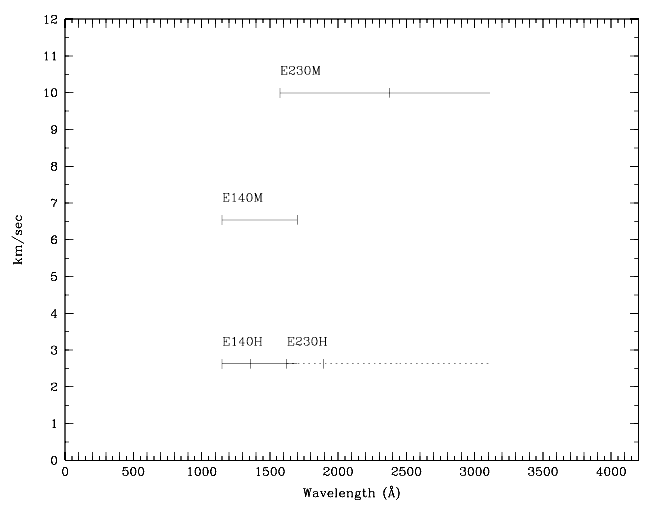



An example of STIS E230H echelle spectroscopy (both the echelle spectrum and a few sample extracted orders) of star CPD-59D2603 showing the interstellar absorption from the Carina Nebula is given in Figure 15.3:. (See also Walborn et al. 1998, ApJ, 492, L169)
There are four echelle grating modes which provide spectroscopic coverage from 1150 Å to 3100 Å at resolving powers from R~30,000 to R~110,000. Through simultaneous observation of multiple orders, they are designed to maximize the spectral coverage achieved in a single exposure of a point source. Figure 4.10 below summarizes the wavelength coverage and kinematic resolutions of the echelle gratings. In short:
Figure 4.10: Echelle Wavelength Coverage vs. Kinematic Resolution. Hatches indicate wavelength coverage at a single scan setting. The dashed line shows the E230H coverage. See Table 4.1 and Chapter 13 for more details.
Short echelle slits, which ensure order separation, are available for use with the echelle gratings. For each mode a short slit of width 0.2 arcsecond is provided, along with a slit whose width matches a two pixel projection in the dispersion direction; either 0.09 arcsecond for the H modes, or 0.06 arcsecond for the M modes. In addition, an ultra-narrow slit of width 0.025 arcsecond (0.1X0.03 in the Proposal Instructions) is supported with all of the echelles, for the highest spectral resolution of bright objects. Also, two multislits with different widths (called the FP-SPLIT slits) are supported for use with the echelles to provide optimally placed multiple exposures which maximize S/N. Their use is discussed in Chapter 12.
Although we don't recommend routine use, the echelle gratings can be used with a long slit (6 x 0.2 arcseconds) to obtain echelle spectroscopy of extended objects with weak continua. Long-slit echelle data will not be calibrated by the STScI pipeline, and they will require more extensive post-observation processing by the user since ambiguous overlap of wavelengths from different parts of sources will occur in the image (see Section 12.2 if you are considering such observations). In addition to the spectral purity considerations in the dispersion direction mentioned above for the first-order gratings, echelle observations are subject to contamination in the cross-dispersion direction by scattered light. This effect is aggravated toward shorter wavelengths as the orders become more crowded. Continuum sources should never be observed with slit lengths greater than 0.2 arcsecond, and even then special data analysis may be required to optimize the accuracy of the results. See Section 13.7.
The properties of each of the echelle gratings are described in detail, grating by grating, in Chapter 13; see the second-to-last column of Table 4.1 for easy reference to the appropriate page for each grating.
The detailed properties of the echelle slits (e.g., throughputs and line spreads as functions of wavelength), the plate scales, and the encircled energies for the echelle modes are presented under Section 13.4, Section 13.5, and Section 13.6.


|
Space Telescope Science Institute http://www.stsci.edu Voice: (410) 338-1082 help@stsci.edu |